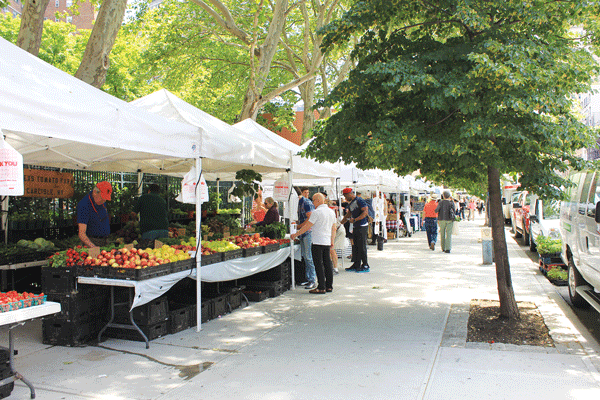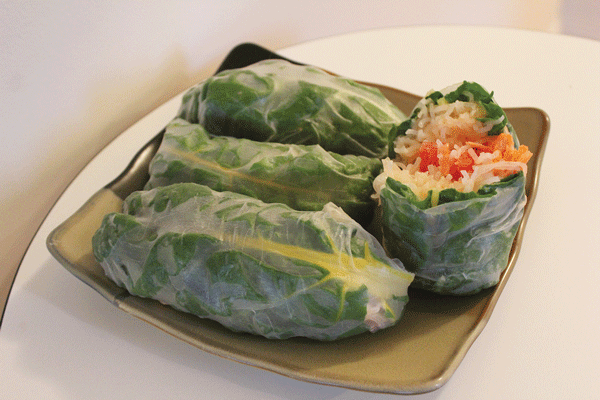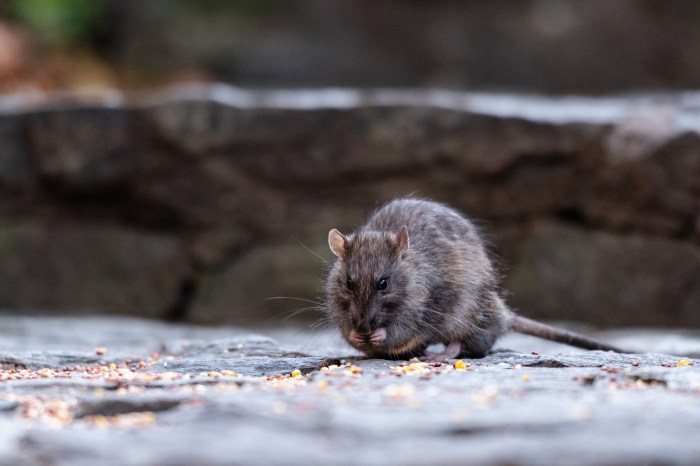
Mere weeks into its inaugural season, the Down to Earth Farmers Market is drawing crowds, improving diets, and earning raves.
BY CARLYE WAXMAN RD, CDN | It’s always exciting to stumble across a farmers market in your neighborhood. The idea that we can buy locally sourced produce makes us feel a little less urban, a little healthier, and can spark an idea to start or end the day off right. But besides knowing there’s beautiful colors, an abundance of produce, and free samples, how much do we really know about our crops? Well, I was lucky enough to speak with the farmers at Chelsea’s Down to Earth Farmers Market, buy some of their produce, and whip up some fabulous concoctions.
THE DOWN TO EARTH FARMERS MARKET
Saturdays, 9 a.m. – 5 p.m.
Through November 22
On the northeast corner
of Ninth Ave. & 23rd St.
E.B.T. (Electronic Benefit Transfer) available for shoppers with SNAP Benefits
Visit DowntoEarthMarkets.com
Alex’s Tomato Farm is located in Carlisle, NY (close to Albany). His 40-acre land is full of herbs, flowers, apples, plums, pears, beans, greens, squash, zucchini, corn, eggplant, peppers, and tomatoes.
Jersey Farm Produce has a wonderful variety of produce such as yellow Swiss chard, popcorn, carrot bunches, and apples (all from Milford, NJ). Hector Perez farms his own land — about 40 acres of veggies and 30 of fruit.
Here’s a little background info on some of the produce you can buy at this market.
BEETS (from Jersey Farm Produce): Beets are a root vegetable and grow very quickly. Even extreme temperatures won’t stop them, so we get to enjoy these all year round. Beets can be a natural food coloring (can you say red velvet?) They’re sweet AND functional — but don’t stain your clothes!
Which one should I choose? Select the beets that are smooth with non-wilted leaves. The smaller ones are more tender. Remove the leaves when you store (leaves are edible). It can be stored up to three weeks, but may last longer. Wash before you’re ready to eat them.
Why is this good for me? One beet provides 35 calories, and is an excellent source of folate.
How do I eat this? Enjoy beets in a stir-fry, or grate into cupcakes or muffins (see Farmers Market Cupcakes with Beet Cream Cheese Frosting Recipe) and eliminate butter from your recipe. The leftover beets can be steamed and enjoyed as a side item the next day!

KALE (from Alex’s Tomato Farm): I don’t know what it is about Kale, but after I eat a bunch of it I feel like I can do an Ironman Triathlon.
Which one should I choose? Make sure they are dark and crispy, not yellow or brown. They can be stored for three to five days in a plastic bag. Buy a big bunch — if all you see are small wilty ones, wait until the crop goes wild again.
Why is this good for me? One cup of kale provides 20 calories, and is an excellent source of Vitamins A and C.
When is kale in season? Kale grows best in the fall and spring. The warm temperatures will trigger vigorous growth (so a week after some warm weather, we may be able to benefit with large bunches of kale for the same price). They sulk in the hot weather and then take off again in the fall when climate gets mild again.
How do I eat this? You can add kale to lasagna instead of spinach, sauté them, or you can make them my favorite way:
QUICK DINNER: Grilled Shrimp And Avocado Kale Salad: Tear off the leaves (throw away stems, they are bitter) and wash well. Make sure you have a hearty supply, as they will come down in volume with liquid. Toss with salt, pepper, sesame oil and white wine vinegar. Grill up some shrimp and throw them into the kale when they are warm. Toss well, and add avocado at the end. It’s the perfect feel good salad.
KOHLRABI (from Alex’s Tomato Farm): Kohlrabi grows in loose, average temperature soil, a great spring or fall crop. They’re not the prettiest, or the lightest, but they’ll make your salads taste great, and are definitely worth the work it requires to carry them home.
Which one should I choose? Choose firm ones, heavy for their size, with no cracks. Refrigerate for up to ten days, and wash before use.
Why is this good for me? Half of a medium Kohlrabi is 25 calories, and an excellent source of Vitamin C and fiber.
How should I prepare this? It tastes like a mix between a cucumber and broccoli with the crunch of cabbage. I recommend you slice it very thin, and throw it into a salad of lettuce, kale, sesame oil and vinegar with toasted almonds for a nice light summer side salad.
YELLOW SWISS CHARD (from Jersey Farm Produce): This crop is easy to grow in the ground and withstands cool temperatures and heat. After two to four weeks, these beautiful green plants will grow, requiring plenty of water. The celery-like stems of Swiss chard also come in red, pink, orange, green, or mixed (aka rainbow).
Which one should I choose? Select those with the best, fullest green leaves. Store them in plastic, unwashed, in the crisper for less than a week or they will lose their form.
Why is this good for me? It’s only seven calories per cup, a good source of magnesium and an excellent source of Vitamins A and C.
How do I eat this? Enjoy them like you would spinach. You can throw them into a soup like minestrone or beef barley, scramble them in eggs, or stir-fry and throw them over brown rice. Utilize their large green leaves as a wrap for sandwiches or for the recipe that follows.
SPICY SWISS CHARD
SUMMER ROLLS
Nutrition Fact: 50 calories per roll.
INGREDIENTS:
4 rice paper rounds (about 10”). Buy them from Whole Foods or an Asian market.
4 very large yellow Swiss chard leaves, stems removed at the ends, wash and dry well
4oz of soba or cellophane noodles, cooked
1 red bell pepper, sliced thin and then halved
1 yellow bell pepper, sliced thin and then halved
1 carrot, grated
SAUCE:
1/2c plain Greek yogurt
1 tbsp sriracha
1 tbsp fish sauce
1 tbsp lemon juice
1 garlic clove, minced (or some sprinkles of garlic powder)
1 tsp agave
Salt and pepper to taste
DIRECTIONS:
Mix the sauce ingredients together and then toss with the peppers, carrots and noodles. Put a large bowl of hot water in front of you, wet a kitchen towel with the water and lay flat. Take one rice paper round, and submerge in the water — but quickly and pull it right out. Set it down on the damp cloth and lay it flat. Add one of the large leaves to fit the whole 10” of the round. Put a handful (or tong full) of the noodle mixture into the wrap. At this point, you could always add some avocado, tofu or chicken if you wanted to make it heartier, but I kept it light. Roll the side closest to you over the mixture, then fold in the sides and roll the rest of it up. Do this four times, and then slice in half.
THE FARMERS MARKET CUPCAKE WITH BEET CREAM CHEESE FROSTING
Makes 24 cupcakes
DRY INGREDIENTS:
3c whole wheat flour (or ½ whole wheat ½ white)
1/2c cocoa powder
1 1/2c sugar
2 tsp baking soda
1 tsp salt
WET INGREDIENTS:
2c skim milk
2 tbsp vinegar
4 tbsp canola oil
4 tbsp applesauce
2 tsp vanilla
PRODUCE:
1/2c beets, shredded
1c shredded zucchini
1/2c shredded apple
FROSTING:
2 tbsp shredded beet
8oz of softened LF cream cheese
1 3/4c of confectioner’s sugar
1 tsp vanilla
DIRECTIONS:
Preheat oven to 350°F, and coat muffin tins with cooking spray. In a liquid measuring cup, combine milk and vinegar and let it sit for 10 minutes, or until it curdles. In a large bowl, mix all dry ingredients. Make a well, and add all wet ingredients one by one (don’t forget milk), stir until just combined (don’t overstir). Fold in the produce. Add to tins and bake 18-20 minutes, or when a toothpick inserted comes out clean. Cool well before adding frosting.
To Make Frosting: Simply beat all ingredients together (works best with electric beater).
Nutrition Tip: These cupcakes can be vegan if you substitute milk for soy milk and don’t add frosting.
Nutrition Facts: 1 cupcake without frosting = 138 calories, 2.7g of protein, and 26g of carbs. Frosting is an additional 69 calories, 11g of carbs.
Carlye Waxman RD, CDN is a Registered Dietitian living in NYC. For more free recipes, nutrition tips or counseling rates visit SweetNutritionNYC.com or email her at Carlye@SweetNutritionNYC.com.

















